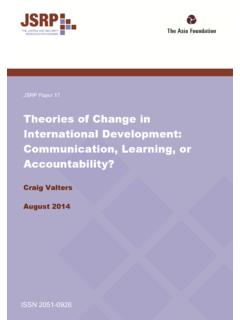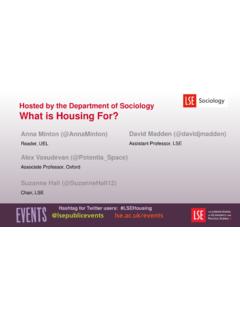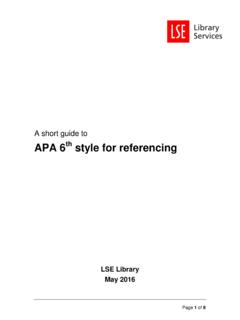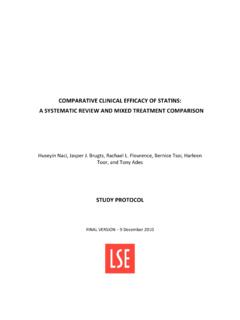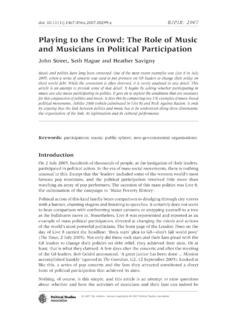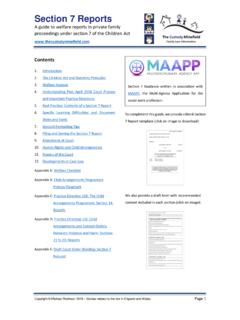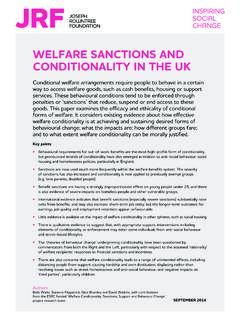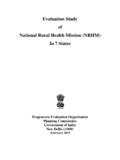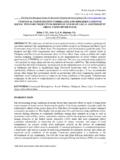Transcription of The introduction of long-term care insurance in …
1 Eurohealth Vol 15 No 128 SNAPSHOTSB ackgroundIn July 2008, Korea introduced a newsocial insurance scheme for long -term care (LTC). Several important demographicand social changes have contributed to theintroduction of LTC insurance , includingthe rapid ageing of the population as aresult of the increase in life expectancy andthe sharp decline in fertility which fellbelow in proportion ofolder people (those over sixty-five) inKorea was 9% in 2005, but is forecast toincrease at an unprecedented rate. Olderpeople are expected to account for 16% ofthe population by 2020 and 38% by 2050,resulting in an old-age dependency ratio of70%.1 With population ageing the demand forLTC has increased.
2 Family structures havealso contributed; the proportion of olderpeople living with adult children haddecreased to 38% by 2004. The availabilityof informal or family caregivers is dimin-ishing, given that female labour partici-pation is increasing and thus they are lesswilling to provide care . Only 36% of thosewho receive LTC also receive care fromtheir spouse. However there are difficultiesin obtaining residential care because thesupply of LTC facilities is limited and,unlike health care which is covered by thehealth insurance programme, there hadbeen no similar system for LTC. In response to these challenges, thegovernment established a PlanningCommittee for long -Term care for OlderPeople in 2000, and President Kim DJformally suggested the need to introduceLTC insurance in 2001.
3 In 2003, PresidentRho MH decided to launch a LTCinsurance scheme in 2007. Legislation waspassed in April 2007, but its implemen-tation was delayed by a year, with thescheme finally coming into operation inJuly 2008. LTC insurance had beenproposed, and indeed was ultimatelyimplemented, by a series of progressivegovernments that strongly supported theexpansion of the welfare s reluctance to expand thepublic assistance programme for long -termcare of (poor) older people has alsocontributed to the rather early adoption ofa universal financing scheme based onpremium contributions. Social insurance for long -term careTax-based financing was never givenserious consideration from the beginningof discussions on a possible LTC financingsystem.
4 Contribution-based socialinsurance financing was adopted becausethe Korean welfare state is based onvarious social insurance schemes such ashealth insurance , pensions, unemploymentinsurance, and workplace injury compen-sation. By making use of the existingadministrative structure of the healthinsurer, the National Health InsuranceCorporation (NHIC), LTC insurance canminimise administrative costs. Path dependency also affects the financingmix: LTC insurance in Korea is not a puresocial insurance , but financing fromcontributions has a greater role than taxsubsidies. As in the case of healthinsurance, the Ministry of Health Welfareand the Family (MHWF) will play a keyrole in the policy for LTC insurance andtightly monitor the insurer.
5 The NHIC,the single payer of health insurance , alsostrongly supports LTC insurance as anopportunity to extend its own operationand mitigate against the pressure of down-sizing/employment adjustment within itsown organisation. LTC insurance , separate from healthinsurance, also has the potential benefit ofbeing able to the de-medicalise LTC. It isalso easier for the government to persuadethe public to pay contributions which areexclusively for LTC. However, the sepa-ration of LTC financing from healthinsurance may be a barrier to coordinationbetween health and LTC if the twodifferent financing schemes try to offloadtheir financial burdens on each other. Population coverageThe new LTC insurance scheme providescoverage for all those over the age of sixty-five, as well as age-related LTC needs foryounger people.
6 As a result, the KoreanLTC insurance scheme does not providecoverage for disability-related care government has prioritised populationageing and related problems, rather thanaiming to solve problems related to the new LTC insurance , targeted tocover only aged-related care needs, willhave a limited effect on social contrast to health insurance , individualsneed to obtain prior approval for servicesthrough an assessment of functional limi-tations. In order to determine eligibility, avisit team from the local branch office ofthe NHIC assesses the functional status ofindividuals using a fifty-six item evalu-ation. There are three levels of functionalstatus/limitations, each with differentbenefit levels. Local assessmentcommittees comprise no more than fifteenmembers, including a social worker andmedical doctor (or traditional medicaldoctor).
7 All decisions of the committee arebased on the assessment of ability toperform activities of daily living (ADL)undertaken by the visit team, alongside adoctor s report. The difference in entitlements compared tohealth care may not immediately be under-stood by older people. Initially there maybe many appeals for reassessment of eligi-bility (functional status) as the LTCscheme is rolled out. The currentThe introduction of long -termcare insurance in South KoreaSoonman KwonSoonman Kwon is Professor of HealthEconomics and Policy, School of PublicHealth, Seoul National University, SouthKorea. Email: scheme will reach about 3-4%of the older population. This, however,appears to fall short of the demand forlong-term care , leading to criticisms thatthe limited coverage threatens the univer-salism of LTC insurance .
8 The governmentdoes though have plans to increase popu-lation coverage incrementally, but progressin achieving this will depend on thefinancial sustainability of the LTCinsurance and type of benefitsContributions to the LTC insurance aredetermined as a fixed percentage ( ) of the health insurance contri-bution, with the two contributionscollected together. Overall, financingconsists of a government subsidy of 20%,co-payment of 20% (institutional care ) or15% (home-based care ), and an insurancecontribution of 60 65%. The poor areexempted from co-payments. Meals andprivate rooms are not covered by LTCinsurance. As LTC delivery in Korea ispre-dominantly private, one potentialchallenge is that private providers mighthave perverse financial incentives to inducedemand for these additional areas ofservice, resulting in an increased financialburden on older people.
9 LTC insurance provides largely servicebenefits. Cash benefits are provided onlyin exceptional cases (for example, when noproviders are available in the region).Benefits depend on the level of functionallimitation determined in the assessmentprocess. There are ceilings on the benefitsfor non-institutional care , ranging from1,097,000 Korean Won (about US$1,000)per month for level one to just 760,000 Korean Won per month for level type of payment to providers variesfrom pay per hour for home care , pay pervisit for home nursing and baths, and payper day for institutional care andday/evening care . The limited role of cash benefits needs tobe re-considered in cash benefitsystem was not adopted because of thepotential for abuse and the low quality ofcare provided by informal care givers.
10 Thefeminist movement, worried about thepotential pressure on women to providecare in the case of cash benefits, did notinfluence the development of the , cash benefits can havepositive effects on consumer choice andcompetition among formal and informalcaregivers. Cost savings may also bepossible when the level of cash benefits islower than that for services. Cash benefitscan also mitigate some of the problemsassociated with the insufficient supply ofLTC service providers in Korea. Delivery of long -term careWhile the number of (private) providers inthe LTC sector has increased rapidly, lackof access to care providers still remains aconcern, with variation across localities apersistent problem. As of 2008, there were1,530 LTC institutions with 64,671 beds,covering of those aged 65 and are 8,011 home care providers,which are estimated to cover of theolder population.

